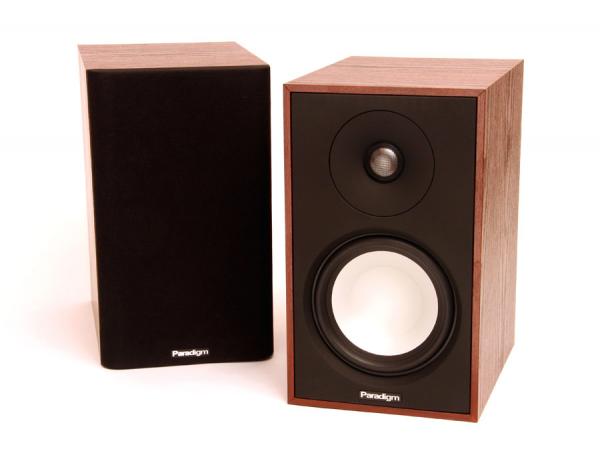Paradigm Atom Monitor 7 Bookshelf Speaker

The Monitor series of speakers from Paradigm is now in its seventh generation. It's always been the company's most affordable line, but it's always been designed in the same no-nonsense, engineering-focused style as the company's other speakers. The Atom Monitor 7 ($398/pr) is no exception.
The diaphragms in both drivers-the 1-inch tweeter and the 5.25-inch woofer-are made from the same S-PAL (satin-anodized pure aluminum) material. There's a shallow waveguide around the tweeter, intended to help its dispersion blend better with that of the woofer, and a fine wire mesh guard over the tweeter to protect it if you use the speaker without its grille (which you should).
The sturdy cabinet is wrapped in generic vinyl fake wood veneer, and the magnetic grille, with no grommets, gives the Atom Monitor 7 a slick look when used sans grille.
Here's the weird thing about the Atom Monitor's sound that you could probably only pick up in a blind comparison, where you're free from the influence of marketing and your own biases. My listening notes raved about the natural sound of the high frequencies—almost as if it had a Heil-type folded ribbon tweeter like the one used in MartinLogan's $799-a-pair Motion 15 speakers. And along with the Monitor Audio Bronze BX-1, the Atom Monitor 7 was the only one of the minimonitors that showed not the slightest trace of vocal sibilance when I played "Shower the People" from James Taylor's Live at the Beacon Theatre. However, I also noticed that when I really pushed the volume, the treble distorted more easily with the Atom than it did with other models under review. I also didn't think the transition between the tweeter and the woofer was as smooth as it could be; occasionally the treble sounded like it was coming from a completely different speaker.
The Atom Monitor 7's bass tends toward the conservative side, more of the tight sound audiophiles like than the get-up-and-boogie high-Q bass that your average guy tends to dig. I noticed during the opening notes of Holly Cole's rendition of "Train Song" that the Atom Monitor sounded a little compressed-yet on the flipside, it never sounded boomy. But you probably know what your taste in bass is, so in this case, I'll report, you decide.
The soundstaging of the Atom Monitor seemed more focused, yet somewhat narrower than with some of the soundstaging champs like the BX1 and the Klipsch RB-41 II. Again, a situation that boils down to taste. Overall, though, the Atom Monitor sounded to me like one of the top contenders in this test.
Speaking of taste, fellow listening panelists Geoff Morrison and Lauren Dragan also ranked the Atom Monitor highly. "Great bass, and maybe a bit 'smiley' (i.e., possessing a frequency response curve with somewhat exaggerated bass and treble), but overall one of my clear favorites. Now let's hear from Lauren: "Technically, this one might be the best. It's definitely the one I'd want to mix a recording on. It sounds the flattest from top to bottom, although the sound seems more clinical and less vivid that with some of the other speakers."
Our summation of the Paradigm Atom Monitor 7? It's as good a <$400/pair minimonitor as we've found.
Measurements
Frequency response of the Atom Monitor 7 measures 65 Hz to 20 kHz ±3.0 dB on-axis, ±5.8 dB avg 0°-30°, which is flatter than any of the speakers in the minispeaker test. If you omit that little dive up around 20 kHz, the measurement is ±2.4 dB on-axis, ±3.4 dB avg 0°-30° . Measured impedance is 4.3 ohms minimum, 8 ohms average. Sensitivity from 300 Hz to 10 kHz averages 85.6 dB.
- Log in or register to post comments






























































